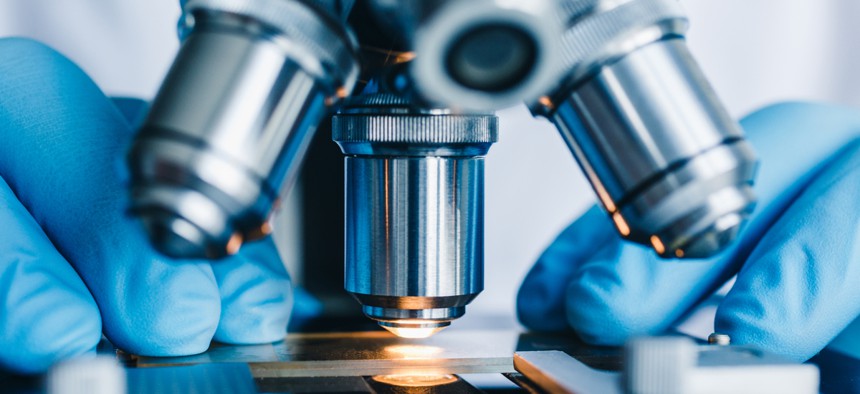Defense Department Jumpstarts Deployment of AI-Driven, Cancer-Detecting Augmented Reality Microscopes

Konstantin Kolosov/Shutterstock.com
Similar capabilities could be applied to the realm of radiology.
An augmented reality microscope packed with artificial intelligence algorithms to rapidly spot metastatic breast cancer cells that appear in digital images was deployed by the Defense Department, for the first time ever, to be used by pathologists at Texas’ Brooke Army Medical Center.
And more microscopes will soon be distributed to other military treatment facilities all around the globe.
Through a new initiative—Predictive Health—the Pentagon’s Joint Artificial Intelligence Center and Defense Innovation Unit teamed up to develop cancer-detecting AI applications that can help quicken the time it takes for patients to decisively be diagnosed with cancer and move into treatment. Industry partners previously offered a glimpse into the effort early last month, but Pentagon officials shared much more details about the data captured and work on the ground, this week.
“This is not an abstract thing,” Warfighter Health Mission Chief Capt. Dr. Hassan Tetteh said in an announcement Wednesday. “What we are doing with these augmented reality microscopes [or ARMs] is delivering AI capability at the point of care. We’ve leveraged computer vision that’s built into the device that can examine the samples and identify the abnormal cancer cells by drawing rings around them even before the pathologist looks at it.”
By equipping the ARMs with AI capabilities, Defense officials hope to help military medical staff on ships and in battlefield locations better prioritize cancer cases and improve workflow optimization. According to the JAIC release, the ultimate intent is that one day in the not-so-distant future, those health care providers can take and upload a medical image for analysis on a cloud-based server—or even conduct the analysis on-site—with “AI algorithms that can examine the entire slide exhaustively for the presence of cancer cells and then report a probability of whether cancer has been detected, what type of cancer, and the grade.”
Predictive Health is one of nearly 30 projects unfolding through the JAIC’s Warfighter Health Mission Initiative, which was launched in 2019 to bring AI-enabled solutions to the U.S. military health system and other health-related DOD components. The center’s blog noted that this particular endeavor “is one of its most advanced product lines,” of that work.
The roots of the multiagency, multidisciplinary Predictive Health project go back to Navy Medical Center San Diego, where a team involved digitized and labeled thousands of pathology samples. Insiders at the JAIC’s Warfighter Health MI have since put those images to use training AI models and refining AI algorithms to help speedily pinpoint and identify certain, specific types of cancer cells.
DIU and JAIC steered a competitive selection process to award contracts that would underpin the creation of an augmented reality microscope that could then overlay the advanced AI-based capability onto present medical case samples. In its release, the center also confirmed “the key to this effort is the massive amount of historical medical data held by” the Pentagon, including 55 million pathology slides representing 7.4 million specimens housed by the Defense Health Agency’s Joint Pathology Center at one location in Maryland. That agency is working to label and digitize a subset of those particular samples, and will be partnering up with other stakeholders to produce and train future AI models and algorithms for cancer and disease detection down the line. And the JAIC noted that “soon, a similar AI capability will also be extended to radiology images.”
Though the center and DIU are collectively working to house the data, it will likely move over to the JAIC’s Joint Common Foundation AI development platform, as it evolves.
For Defense insiders, the ultimate hope is that the technological tools will accelerate cancer diagnostics and treatment, across military avenues where resources might be limited. Recalling his time as a surgeon stationed on a U.S. Navy aircraft carrier, Tetteh noted he often treated patients who would develop suspicious skin lesions from spending a great deal of time on deck in direct sunlight. It would often take weeks—sometimes, months—until the ships would reach port and Tetteh could transfer biopsies he took for diagnoses over to pathologists for insights.
“It was not uncommon for some of those lesions to come back as early cancers. You can imagine how that kind of time delay can impact the ability to treat a cancer case optimally,” Tetteh said, later adding that “there’s a lot of capability and a lot of potential use and application for how AI can be used to advance our diagnostics.”






